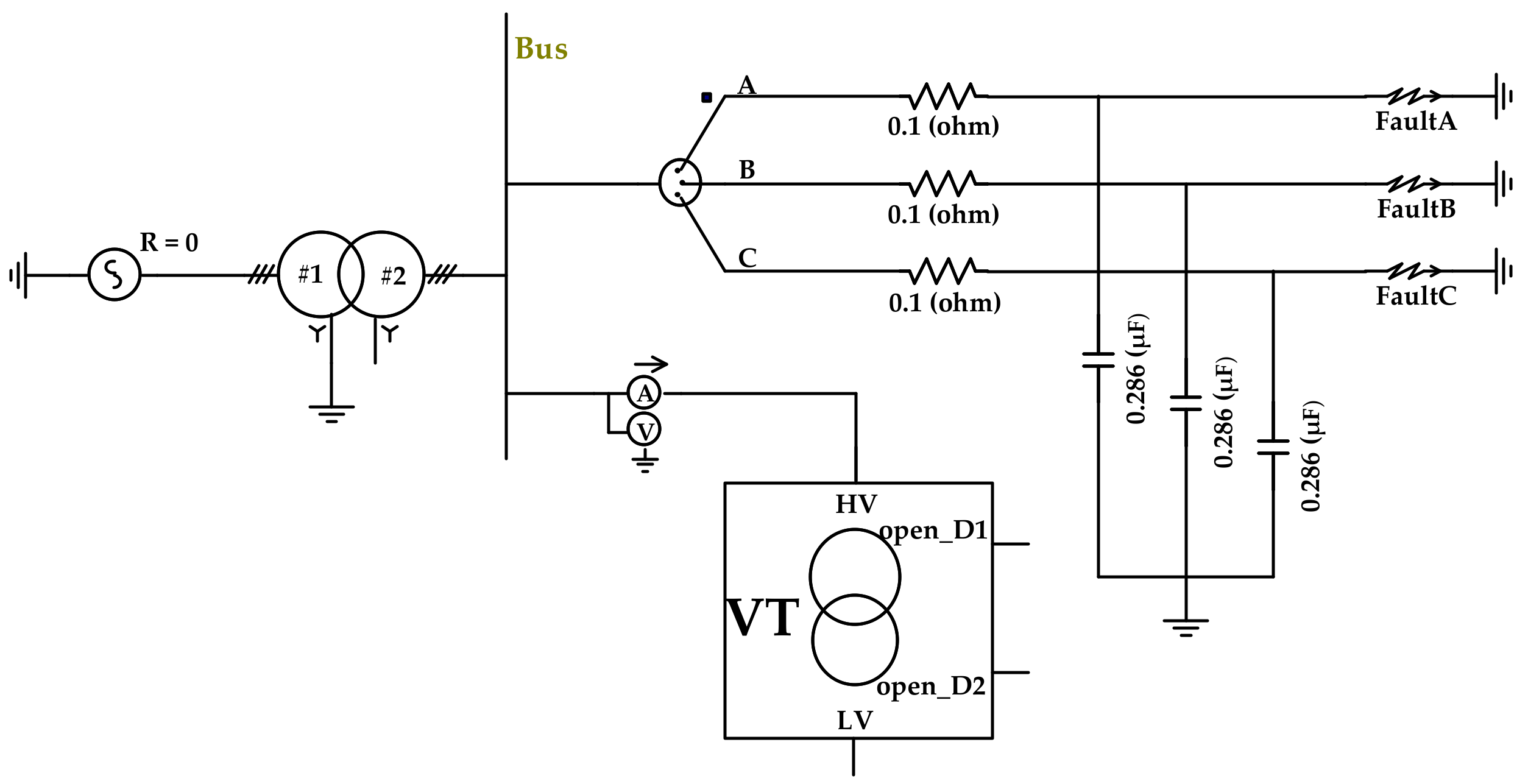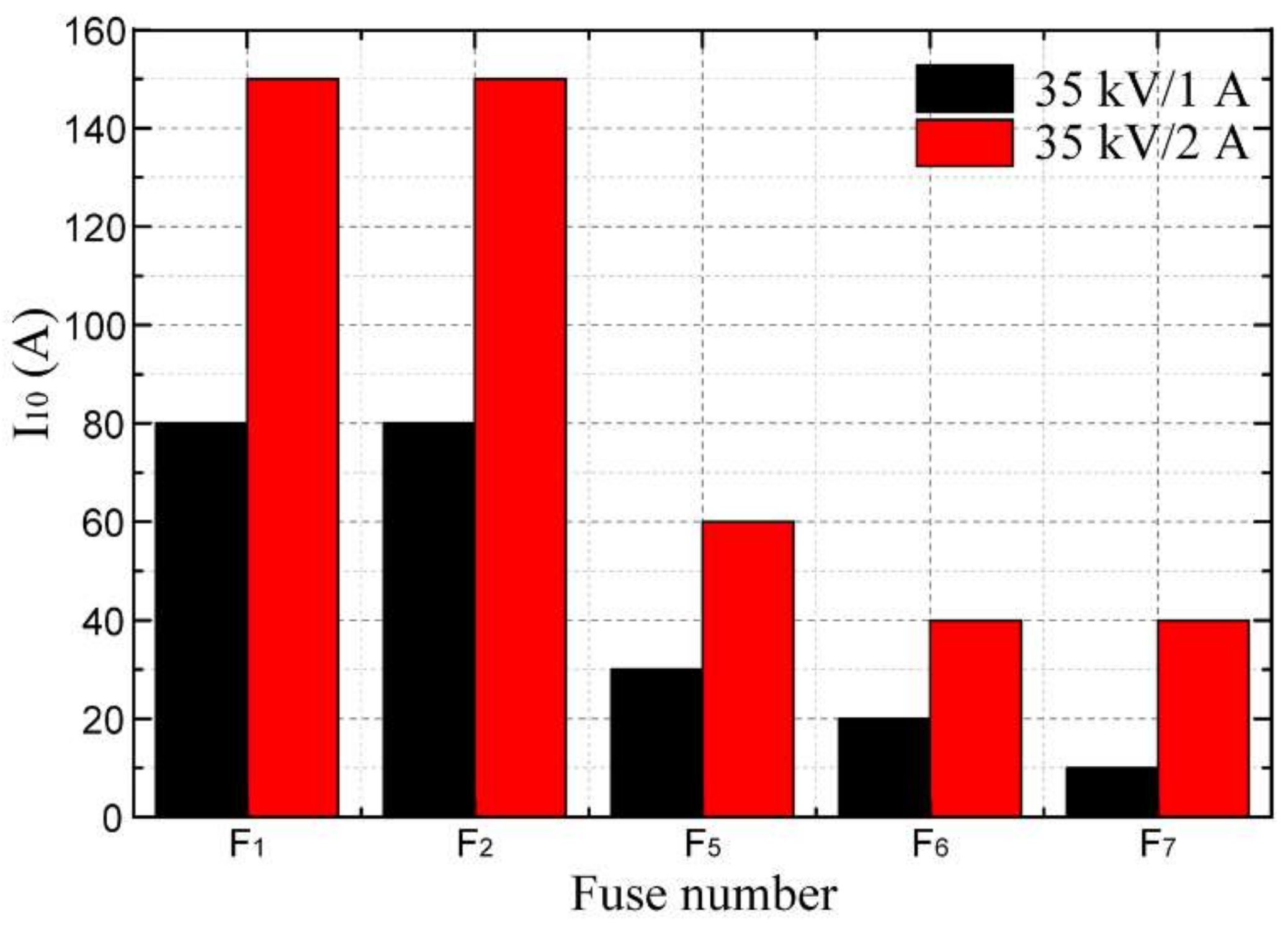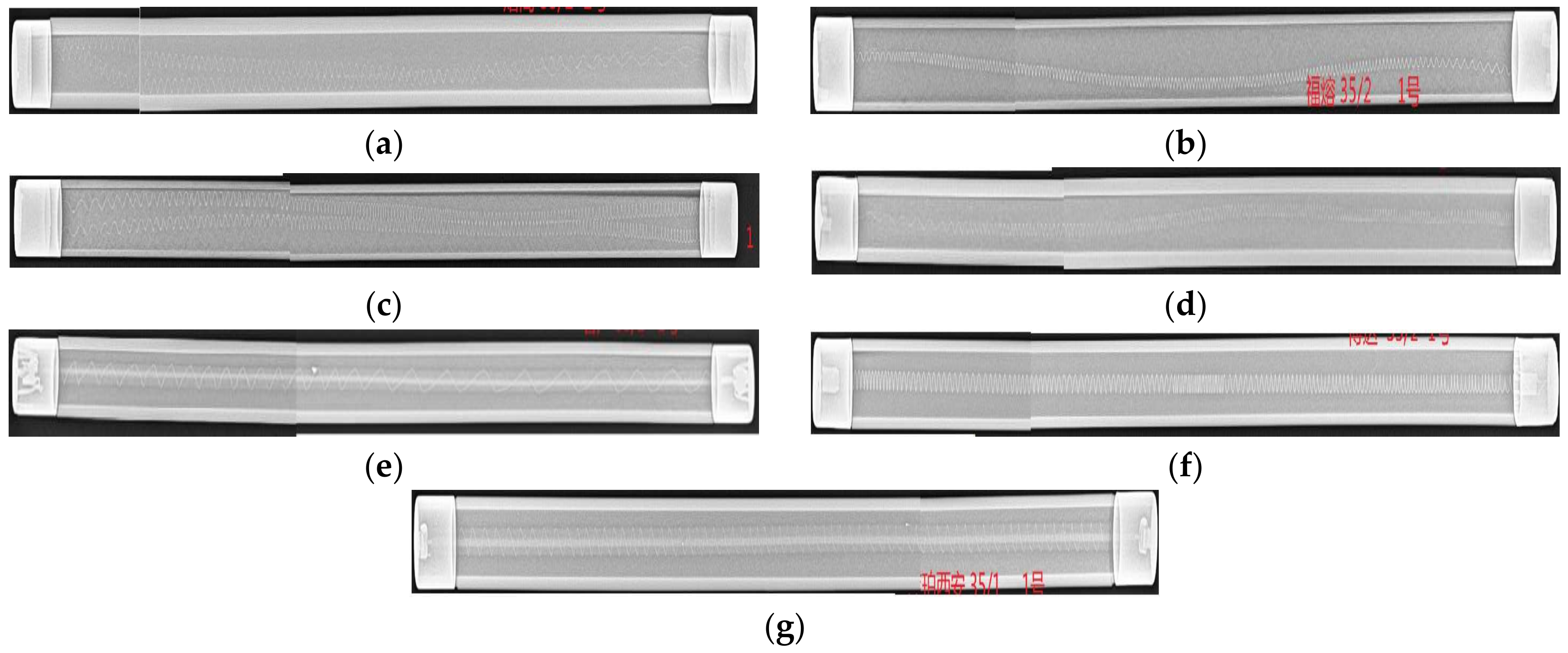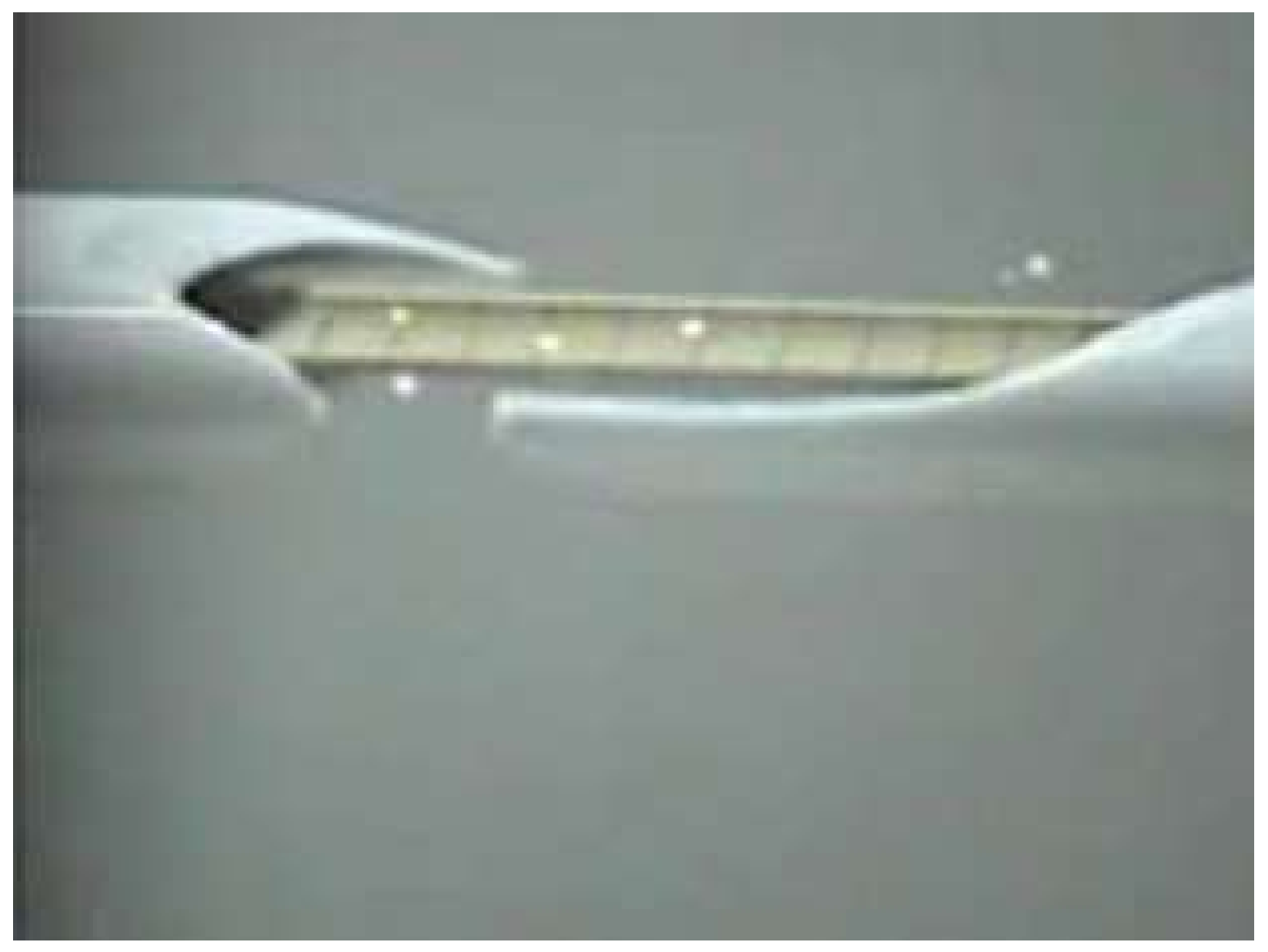Impact Transient Characteristics and Selection Method of Voltage Transformer Fuse
Abstract
:1. Introduction
2. Testing and Analysis of Fuse Current Characteristics
2.1. Steady Current Characteristics
2.2. Electromagnetic Transient Impact Characteristics
3. Breaking Characteristics
4. X-Ray Examination
5. Corona Characteristics
6. Conclusions
Author Contributions
Funding
Conflicts of Interest
References
- Xie, Y.-X.; Wang, J.-M. Review of high voltage full range fuses. High Volt. Appar. 1987, 4, 50–55. [Google Scholar]
- Tanggawelu, B.; Mukerjee, R.N.; Ariffin, A.E. Ferroresonance studies in malaysian utility’s distribution network. In Proceedings of the 2003 IEEE Power Engineering Society General Meeting (IEEE Cat. No.03CH37491), Toronto, ON, Canada, 13–17 July 2003; pp. 125–128. [Google Scholar]
- Clarke, E.; Peterson, H.A.; Light, P.H. Abnormal Voltage Conditions in Three-Phase Systems Produced by Single-Phase Switching. Electr. Eng. 1941, 60, 329–339. [Google Scholar] [CrossRef]
- Iravani, M.R.; Chaudhary, A.K.S. Modeling and analysis guidelines for slow transients-part: The study of ferroresonance. IEEE Trans. Power Deliv. 2000, 15, 255–265. [Google Scholar] [CrossRef]
- Mork, B.A.; Stuehm, D.L. Application of nonlinear dynamics and chaos to ferroresonance in distribution systems. IEEE Trans. Power Deliv. 1994, 9, 1009–1017. [Google Scholar] [CrossRef]
- Li, Y.; Shi, W.; Qin, R. A systematical method for suppressing ferroresonance at neutral-grounded substations. IEEE Trans. Power Deliv. 2003, 18, 1009–1014. [Google Scholar] [CrossRef]
- Emin, Z.; Al Zahawi, B.A.T.; Auckland, D.W. Ferroresonance in electromagnetic voltage transformers: A study based on nonlinear dynamics. IEE Proc. Gener. Transm. Distrib. 1997, 144, 383–387. [Google Scholar] [CrossRef]
- Chakravarthy, S.K.; Nayar, C.V. Series ferroresonance in power systems. Int. J. Electr. Power Energy Syst. 1995, 17, 267–274. [Google Scholar] [CrossRef]
- Walling, R.A. Ferroresonance in low-loss distribution transformers. In Proceedings of the Power Engineering Society General Meeting, IEEE, 2003, Toronto, ON, Canada, 13–17 July 2003. [Google Scholar]
- Radmanesh, H.; Gharehpetian, G.B. Ferroresonance suppression in power transformers using chaos theory. Int. J. Electr. Power Energy Syst. 2013, 45, 1–9. [Google Scholar] [CrossRef]
- Nattapan, T.; Boonyang, P.; Hideaki, O. Analysis of Ferroresonance Phenomenon in 22 kV Distribution System with a Photovoltaic Source by PSCAD/EMTDC. Energies 2018, 11, 1742. [Google Scholar]
- Lin, C.; Qing, Y.; Jing, W.; Wenxia, S.M. Classification of Fundamental Ferroresonance, Single Phase-to-Ground and Wire Breakage Over-Voltages in Isolated Neutral Networks. Energies 2011, 4, 1301–1320. [Google Scholar] [Green Version]
- Wang, M.-Q.; Chen, W.-J.; Li, Y.-J. A countermeasure to deal with abnormal fusing of high voltage fuse for potential transformer in 35 kV oilfield power distribution system. Power Syst. Technol. 2012, 36, 283–288. [Google Scholar]
- Liang, Z.-R.; Zhao, M.-Y.; Niu, S.-S.; Liu, H.-S.; Liang, S.; Guo, Y.-C. Study on Defects and New Measures of Control Measures for Fuse Fuse of Voltage Transformer in Distribution Network. Electr. Power Autom. Equip. 2016, 36, 17–24. [Google Scholar]
- Zhou, X.-M.; Yang, Y.-H.; Tan, W.-P. Analysis of Causes of Fuse of PT High Voltage Fuse in Distribution System. Mod. Electr. Power. 2007, 24, 34–37. [Google Scholar]
- Adrian, P. Temperature Distribution of HBC Fuses with Asymmetric Electric Current Ratios through Fuselinks. Energies 2018, 11, 1990. [Google Scholar]
- Zhou, T.; Wen, Y.-F.; Mao, L.-M.; Liu, X.-F. High-voltage current-limiting fuse with EMTP/ATP. High Volt. Eng. 2007, 10, 37–40. [Google Scholar]
- Wu, A.Y.; Yin, Y. Fault-current limiter applications in medium and high-voltage power distribution systems. IEEE Trans. Ind. Appl. 1998, 34, 236–242. [Google Scholar] [CrossRef]
- Fortin, M. Characteristics of High-Voltage Current-Limiting Fuses for Distribution Systems. IEEE Trans. Power Appar. Syst. 1982, PAS-101, 2056–2060. [Google Scholar] [CrossRef]
- Wang, H.; Li, H.; Tao, G. Research and Application of 10kV Built-in High Voltage Protection Distribution Transformer. In Proceedings of the 2018 China International Conference on Electricity Distribution (CICED), Tianjin, China, 17–19 September 2018; pp. 280–284. [Google Scholar]
- Zhou, W.; Li, H.; Yi, X.; Tu, J.; Yu, J. A Criterion for UV Detection of AC Corona Inception in a Rod-plane Air Gap. IEEE Trans. Dielectr. Electr. Insul. 2011, 18, 232–237. [Google Scholar] [CrossRef]
- Wang, S.; Lv, F.; Liu, Y. Estimation of discharge magnitude of composite insulator surface corona discharge based on ultraviolet imaging method. IEEE Trans. Dielectr. Electr. Insul. 2014, 21, 1697–1704. [Google Scholar] [CrossRef]
- Li, Z.; Li, L.; Jiang, X.; Hu, J.; Zhang, Z.; Zhang, W. Effects of Different Factors on Electrical Equipment UV Corona Discharge Detection. Energies 2016, 9, 369. [Google Scholar] [CrossRef]


















| Fuse Number | F1 | F2 | F3 | F4 | F5 | F6 | F7 |
|---|---|---|---|---|---|---|---|
| Main component | Cu | Cu | Cu | Cu | Ag | Ag | Ni |
© 2019 by the authors. Licensee MDPI, Basel, Switzerland. This article is an open access article distributed under the terms and conditions of the Creative Commons Attribution (CC BY) license (http://creativecommons.org/licenses/by/4.0/).
Share and Cite
Wang, K.; Liu, H.; Yang, Q.; Yin, L.; Huang, J. Impact Transient Characteristics and Selection Method of Voltage Transformer Fuse. Energies 2019, 12, 737. https://doi.org/10.3390/en12040737
Wang K, Liu H, Yang Q, Yin L, Huang J. Impact Transient Characteristics and Selection Method of Voltage Transformer Fuse. Energies. 2019; 12(4):737. https://doi.org/10.3390/en12040737
Chicago/Turabian StyleWang, Ke, Hongwen Liu, Qing Yang, Lu Yin, and Jisheng Huang. 2019. "Impact Transient Characteristics and Selection Method of Voltage Transformer Fuse" Energies 12, no. 4: 737. https://doi.org/10.3390/en12040737




